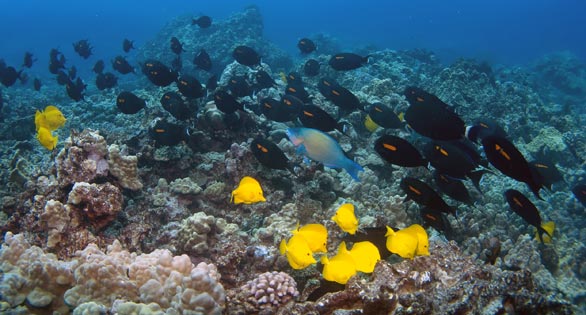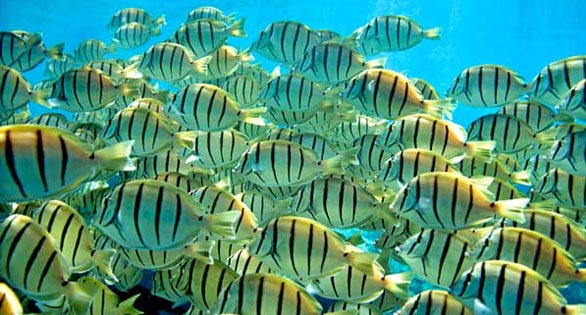Trying to establish a sustainable trade and preserve a future for marine livestock collectors
Hawaii’s marine aquarium fishery has been at the forefront of a debate regarding the marine aquarium trade for several years now, with little movement in terms of how the fishery is actually managed despite a lot of talk. That may change in January, when the Board of Land and Natural Resources hears the summary of public comments and makes a decision on two rules packages which could impact both the O’ahu fishery and the West Hawaii fishery.
Aquarists and others interested in helping to determine how these fisheries are ultimately managed must submit written testimony by Wednesday, December 19, 2012 in order to have their voices heard at the Board of Land and Natural Resources meeting.
Different Fisheries and Different Rules Packages

Dr. William Walsh, strong proponent of new regulations to protect reef species—and the fishers who collect them.
The two rules packages are separate entities and would affect separate fisheries. For those unfamiliar with the Hawaii aquarium fishery, this may seem strange given that both fisheries are in state waters and managed by the same state agency. The reality is that the two fisheries—one located off O’ahu and fished mostly by O’ahu fishers and one off of the Big Island fished mostly by Big Island fishers—are very different. The O’ahu fishery is far smaller and relies heavily on fishers who generally collect a diversity of species that are often higher-value species, while the Big Island (West Hawaii) fishery is much larger and depends more on fishers who target just a couple of species like the emblematic Yellow Tang (Zebrasoma flavescens) in far larger numbers.
While controversy surrounds both rules packages, the O’ahu rules package is far less contentious. O’ahu fishers, especially insofar as it relates to this rules package, are generally seen by the community as proactive and interested in regulations that will insure the longterm sustainability of the O’ahu commercial marine aquarium fishery. The West Hawaii rules package, officially the West Hawaii Regional Fishery Management Area Rules Package, is the result of more than a decade of mutistakeholder work and includes some individual rules that are far more controversial than anything in the O’ahu rules package. Both rules packages were drafted by the Department of Land and Natural Resources (DLNR) Division of Aquatic Resources (DAR) based on collaborative work with fishers, fishery managers, scientists, and other community members both for and against the marine aquarium trade. Unlike legislative initiatives to regulate or abolish the marine aquarium trade, these rules would go into effect as part of the often lengthy rule-making process as provided for under state law.
New Rules and Amended Regulations
The rules packages themselves include new rules and amended regulations. In the case of the O’ahu rules package, there would be new regulations for net sizes, as well as bag and slot (size) limits for certain species, none of which have proven terribly controversial beyond the usual anti-trade rhetoric.
The West Hawaii rules package, on the other hand, involves new rules that have proven highly controversial both in terms of the aquarium fishery and other fisheries in the West Hawaii Regional Management Area. Approval of the West Hawaii Rules package would mean the a 40-species “White List” would go into affect, restricting Big Island aquarium fishers’ catch to the species on the list.
In addition, approval of the West Hawaii Rules package would result in bag and slot (size) limits for certain species on the white list, including the yellow tang. In addition to the aquarium-specific rules included in the West Hawaii rules package, there are provisions for banning SCUBA spearfishing and protecting nine species of sharks and rays, as well as two crown of thorn sea star-eating invertebrates. Both rules packages are available online where they may be read in their entirety.
On December 5th, both rules packages received public hearings, a final step before going to the Board of Land and Natural Resources for a vote. Like the packages themselves, the O’ahu hearing was generally less contentious, while the West Hawaii hearing nearly got out of hand. Around 50 people attended the O’ahu hearing, which was small compared to the Big Island hearing, which was attended by more than 250 people.
While anti-trade activist attended both meetings, it was perhaps those opposed to the SCUBA spearfishing ban who were most vocal. While many local Hawaiians argue that SCUBA spearfishing is about feeding their families, those supporting the ban say it is akin to slaughter, especially when vulnerable species that sleep in the open are targeted at night. SCUBA spearfishing is already banned in most other regions in the Pacific and elsewhere because of the potential for over-exploitation. There is some concern by fishers and fisheries managers who support the rules package that the SCUBA spearfishing ban could derail the entire process, as any substantive change to the rules package would necessitate a return to the drafting phase.
“Not Perfect” but an “Important Step” Toward a Better Managed Fishery
Just about everyone involved in, and potentially affected by, the West Hawaii rules package agrees it is not perfect, but many also argue it is an important step in the right direction toward a better managed fishery that will be easier to assess and, in turn, be more defensible against accusations frequently levied against the trade. Fisheries managers point out, for example, that while the so-called White List remains somewhat controversial, it will limit the fishery largely to the fishes about which the most data exists.
“We have a substantial amount of biological information on most of the species on the White List,” says Dr. William Walsh, a state aquatic biologist with DAR in West Hawaii. “Coupled with aquarium fisheries data we can clearly say we know what’s going on out there, and we can therefore manage the fishery appropriately.” The White List also represents the majority of the fishery’s value, so most fishers will not be impacted significantly by only having 40 species open to them.
Those closest to the situation, including some fishers and fishery managers, are warning this public comment period is not the time for debating the specifics of the respective rules packages, especially in the case of the West Hawaii package. Several lengthy and thoughtfully-written pieces of testimony submitted to date and largely in support of the West Hawaii rules package have actually been recorded as written testimony against the rules package and will be presented as such at the Board of Land and Natural Resources meeting in January. Because any substantive change to the rules packages at this point, according to the State Attorney General, could send the rules package back to the drafting phase, debating an aspect of the rules package in one’s testimony is essentially asking the Board to not approve the rules package.
Anti-trade activists, who are largely against the rules packages, argue both fishers and agents of the State who are encouraging people to vote in support of approving the rules package are using scare tactics to try to strong-arm through their agenda. Most anti-trade activists say both packages fall far short of the statewide ban they would like to see placed on the aquarium trade.
A New Player Engages Publically in Defense of Aquarium Fisheries
Perhaps one of the most interesting developments in the past year regarding the Hawaii aquarium fishery is the Pet Industry Joint Advisory Council’s (PIJAC) proactive and public engagement in the debate around the fishery.
“PIJAC has a long record of advocating on behalf of the ornamental fish fisheries,” Mike Canning, PIJAC President and CEO tells CORAL Magazine. “We support fishing sustainability, and the trade which we represent has consistently taken a position of fishing responsibility and has been supportive of proactive fishery management.” While PIJAC has been engaged in what some have characterized as “a more behind-the-scenes role” in advocating on behalf of the marine aquarium trade, most aquarists familiar with PIJAC associate the organization with the more ubiquitous cat and dog side of the pet industry. Beginning last year, however, with numerous pieces of legislation on the table in Hawaii that threatened to severely curtail or even abolish the State’s aquarium trade, PIJAC became more publically engaged both by direct advocacy and by initiating public campaigns encouraging aquarists and others in trade to become involved.
It remains to be seen how PIJAC, in its more public role, will work with significant elements of the aquarium trade that have not consistently taken a position of fishing responsibility. In the case of Hawaii, however, PIJAC remains confident that improvements to the Hawaii marine aquarium fishery will insure that the fishery is truly of model of sustainable fisheries management. “[PIJAC] is actively involved with the current Hawaiian proposal to adopt a suite of regulations designed to improve the O’ahu and West Hawaii regulatory system,” says Canning. “It is our firm belief that working together with the Hawaiian Department of Land and Natural Resources and the Division of Aquatic Resources and the affected community of fishermen a reasonable regulatory regime can be structured.” PIJAC is recommending interested persons submit testimony in support of approval of both rules packages and says it is receiving “tremendous support” from those engaged in both the trade and the hobby. “[These individuals] recognize that Hawaii needs a reasonable set of rules that will benefit the long term health of marine resources and promote sustainability,” says Canning. “Working together with DLNR we are encouraged that we can accomplish our collective goals.”
Failure to Approve Rules Could be “Disastrous”
For its part, DAR believes failure to adopt these rules packages could be devastating, especially in the case of West Hawaii, where both the fishery and the community-based, multi-stakeholder process are under particular scrutiny. “This effort,” says Walsh, “is the result of over 10 years of research, seemingly never-ending committee meetings and public discussions, and mind-gobbling bureaucratic delays. It’s critical for those who are concerned with the well-being and sustainability of our marine resources to provide testimony in support of approval of the rules package.”
The results of the public hearings and written testimony will be presented to the Board of Land and Natural Resources, a seven-member board chaired by DLNR executive head William J. Aila Jr., in January for final review. Testimony to be summarized at that meeting should be submitted separately to both Kona DAR and Honolulu DAR.
WHERE TO SUBMIT COMMENTS
Aquarists and others interested in helping to determine how these fisheries are ultimately managed must submit written testimony by Wednesday, December 19, 2012 in order to have their voices heard at the Board of Land and Natural Resources meeting.
West Hawaii Regional Fishery Management Area Rules Package testimony to darkona@hawaiiantel.net
Hawaii Administrative Rules for Management of Aquarium Fish Collecting on O’ahu testimony to Alton.K.Miyasaka@hawaii.gov








Trackbacks/Pingbacks